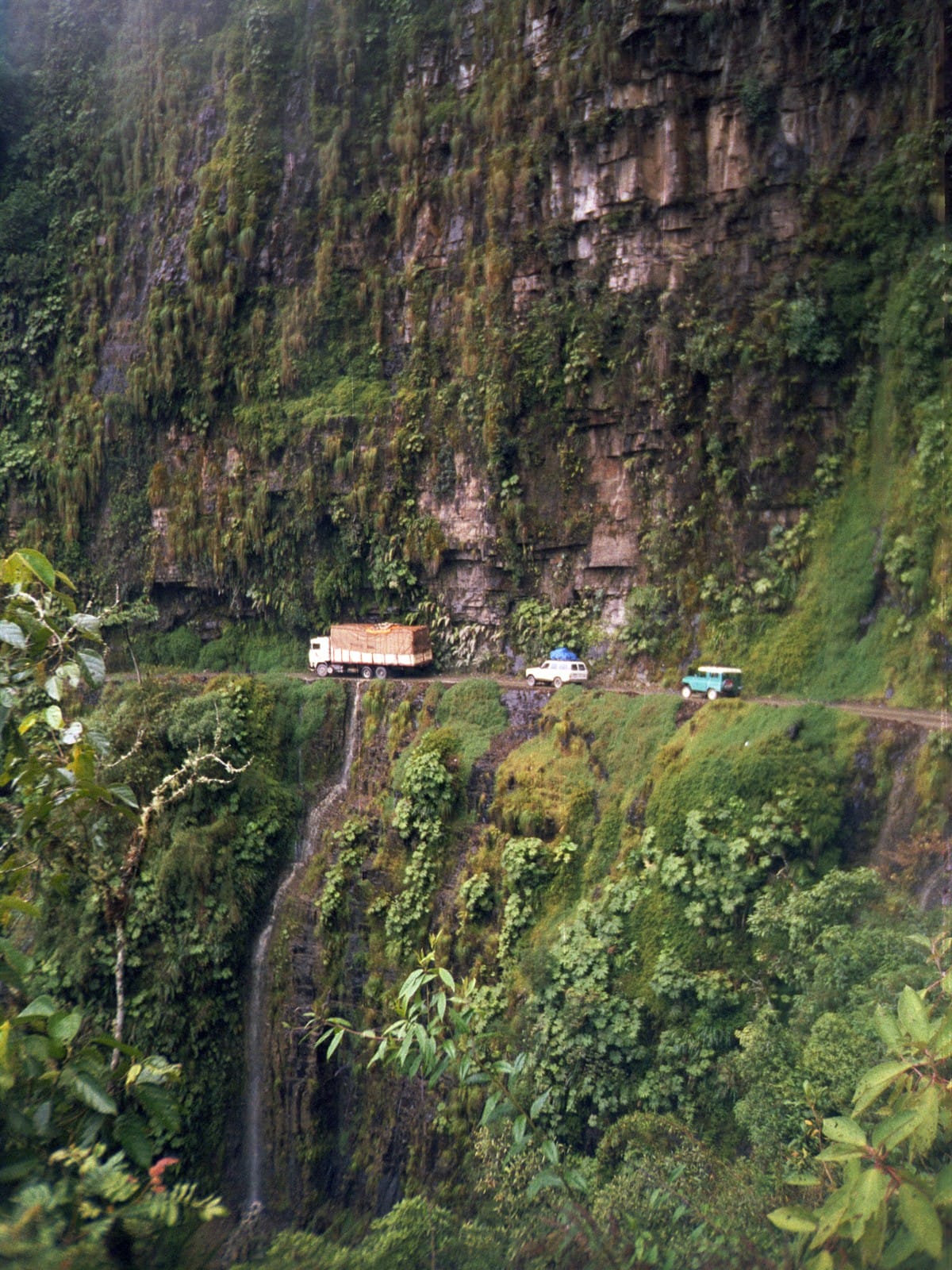
5 Roads you Never Want to Drive
Although we often complain about the amount we have to pay for our insurance, the driving experience in Canada is actually pretty darn good. Can you imagine what you would have to pay if you always drove on these roads?
Eyre Highway – Slaughter Alley
The Eyre Highway has gained notoriety for being incredibly long, flat and straight. And being in Australia, this road is far better maintained then many roads on this list. Which begs the question: why would we ever include it?
Because of this. Eyre Highway is incredibly long (1675 kilometers), flat, and straight, cutting through the equally long, flat, and straight Nullabor Plains section of Australia. Nullabor has few trees, is sparsely populated, and is generally devoid of distinctive visual landmarks. Are you beginning to see where the danger might emerge?
If you have trouble paying attention to the road on a crowded (by Eyre’s standards at least) Canadian highway, just imagine what it would be like driving on this. No dividers and no attentive drivers leads to an appalling number of head on collisions and other accidents as drivers get distracted, daydream or even fall asleep at the wheel! Fatalities and a number of critical injuries have lead to this peaceful road getting a bad reputation in Australia, so bad it’s been given the nickname of “Slaughter Alley”.
Cleveland Innerbelt – Dead Man’s Curve
You know what is a good thing to include on a busy highway, in the middle of a large American city? A 90 degree turn.
That’s Interstate 90 in Cleveland, Ohio, right where the Cleveland Memorial Shoreway connects to the Innerbelt Freeway, and it is as close to a right angled turn as you are going to get on a max speed highway. It wasn’t ever designed to be this way – originally Interstate 90 was supposed to continue west along the shoreline of Lake Erie, but that never materialized, resulting in a turn affectionately known as the “Dead Man’s Curve”. To be honest, it doesn’t look that terrible on Google maps.
Nevertheless, the curve is still very dangerous. Combining a really harsh turn with high speeds creates ideal conditions for vehicle rollovers, and the rapid deceleration and the challenge of staying in your lane leads to way above-average numbers of accidents every year.
Of course, the turn used to be much, much worse. After it became abundantly clear that motorists couldn’t handle the sharp turn (who would have thought), authorities took a number of steps to improve safety. They banked it’s curve, drastically cut its speed limit, and added rumble strips and an array signs, to great effect. Their actions drastically increased the safety of “Dead Man’s Curve”, improving a crash rate that was almost 3 times higher than the national average. However, they have not taken all the bite out of the curve, which remains dangerous and requires drivers to practice the utmost caution while driving it.
Karakoram Highway – The New Silk Road
The Karakoram Highway, or the KKH, is the world’s highest paved international road, connecting China and Pakistan. Not exactly the background you would expect for a safe, reliable road.
The KKH is a marvel of construction, being etched into mountainsides, across canyons and through immensely treacherous terrain. However, despite the poetry beauty of such a triumph of human construction, there is a good reason why most roads are not typically constructed through such geography. It makes for extremely dangerous driving.
Low clouds and fog can drastically limit vision and complicate navigating, as can blizzards or sporadic, heavy, rainfall. Entire sections of the road are known to flood in periods of fairly regular precipitation, while others are regularly pulverized by landslides. Oh, and this highway crosses into a highly unstable political area, and terrorists have been reported to stake out the road. Lovely.
Of course, what road would be complete without health concerns? Although the extremely high altitude can provide for some scenic views, it is also quite dangerous. Altitude sickness commonly occurs at roughly 2,400 metres above sea level, which is roughly half of the KKR’s highest point of 4,700 metres. Common symptoms include nausea, drowsiness and shortness of breath, but altitude sickness can progress to pulmonary or cerebral edema (fatal fluid buildup in your lungs or brain).
Combine all of these factors with a road that looks like this, and you’ve got yourself a shoe-in for becoming part of this list.
M56 Lena Highway – The Highway from Hell
In Russia, there exists a highway which stretches 1,235 miles from the Trans-Siberian railroad all the way to Yakutsk, the capital of Russia’s Sakha Republic. It is big. It is long. It is a highway which has been referred to around the world as “The Highway from Hell”, because of the horrific experiences of many who travel it. It is the world famous mud-highway: the M56 Lena.
You see, despite its length and girth, the M56 is not paved. Instead, it is merely a path of compacted dirt which vehicles use to travel. Yakutsk, the M56’s most nothern destination, is the coldest city on the planet. Therefore it should come as no surprise that the ground of the M56 is frozen most of the year, making for very brisk travel – the posted speed limit is 70km/h. However, for roughly two months of the year, the frost thaws, making the only link between Yakutsk (a city of 200,000 people) and the rest of Russia a deadly sinktrap.
With summer temperatures reaching a climate similar to Ontario in July and August, rainfall robs the M56 of any structural integrity, turning it into the worlds longest, and most dangerous mudpit. Engines are destroyed, vehicles are swallowed whole, and motorists become stranded; embroiled in muck for weeks. Authorities can’t help, for fear of becoming stuck themselves, and the lack of surveillance over the M56 leads drivers to run into this deathtrap without any warning.
Often a trip to Yakutsk can become a real life version of Hatchet, where drivers become stranded without food, water or electronics, barely living out of their car. They are stuck, sometimes for days, as they await rescue from the limited number of emergency vehicles or for the muck to solidify once more. So remember that next time your trip takes an extra hour because of the traffic in Toronto.
Yungas Road – The Death Road
How do you feel, knowing that this road has claimed hundreds of lives… not in its history, but in this past year. That’s about all you need to know about the Yungas Road, which is situated in Bolivia, a country within the heart of South America. Yungas road is consistently ranked as the world’s most dangerous road, and it is easy to see why. Just googling “Yungas Road” will give you an array of chilling pictures which show you exactly why this road collects so many fatalities. All along the road, you will see crosses placed on its sides, remembrances of those who died traversing this “Road of Death”.
For starters, this road is situated in the West Andes, a dense tropical mountain range with heavy mist and regular rain. This makes for poor driving even on the best of roads, but is actually just a minor inconvenience compared to the true terror of Yungas.
You see, Yungas is a dirt road carved into what is basically sheer cliff. On one side, the straight cliff mountainside, towering above you, and on the other, a 900 foot drop. Straight down. No guard rails, few signs, and several completely blind hairpin turns. And the road is only wide enough for one lane, but gets used for both directions of traffic.
This means that often you are passing a vehicle which is literally scraping a mountain wall, while your car is about 2 inches from falling off a cliff completely. And because only certain spots of the road are wide enough for this sort of insane pass, you often have to reverse along the dirt road, with the 900 foot drop, obscured by fog, until you reach a section of a road that is just wide enough. It’s no wonder this road is deadly enough to claim a life almost every other day. Check out this video to see what I mean.
Although traveling on a tropical mountainside where you at a few points literally drive through waterfalls sounds picturesque and beautiful, it loses its attractiveness quite quickly with the constant threat of buses and trucks pushing you off a mile high precipice. Driving on this road would certainly increase the cost of your auto insurance, but I think it’s effect on your life insurance premiums would be far more pronounced.
So next time you get stuck at two red lights on your way to work, or get cutoff by a jerk on a cellphone, take a deep breath and gain some perspective. It could be a lot, lot worse.
You Might Want to Read
June 15, 2025
Sideswipe Collision: Who Is at Fault in Sideswipe Accidents?
June 15, 2025
Least Depreciating Cars in Canada
June 5, 2025
Welcome to the Team Keyes Insurance


